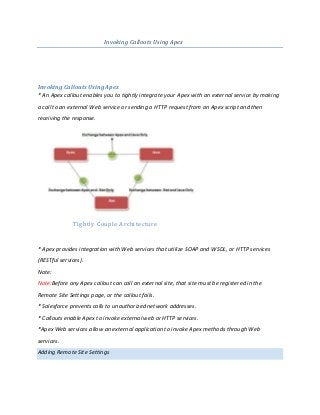
Invoking callouts using apex
- 1. Invoking Callouts Using Apex Invoking Callouts Using Apex * An Apex callout enables you to tightly integrate your Apex with an external service by making a call to an external Web service or sending a HTTP request from an Apex script and then receiving the response. Tightly Couple Architecture * Apex provides integration with Web services that utilize SOAP and WSDL, or HTTP services (RESTful services). Note: Note:Before any Apex callout can call an external site, that site must be registered in the Remote Site Settings page, or the callout fails. * Salesforce prevents calls to unauthorized network addresses. * Callouts enable Apex to invoke external web or HTTP services. *Apex Web services allow an external application to invoke Apex methods through Web services. Adding Remote Site Settings
- 2. To add a remote site setting: 1. Click Your Name ➤ Setup ➤ Security Controls ➤ Remote Site Settings. 2. Click New Remote Site. 3. Enter a descriptive term for the Remote Site Name. 4. Enter the URL for the remote site. 5. Optionally, enter a description of the site. 6. Click Save. Types of WSDL's 1. Enterprise WSDL * It is a big WSDL which contains information about schema of organization. * Strictly Typed: For Integer if we give 3.19 like that then it will not accept and throw error. * When schema is modified then we have to recreate new enterprise WSDL. 2. Partner WSDL * Loosly Typed: For Integer if we give 3.19 like that then it will accept and not throw error. * When schema is modified then it will automatically updated. SOAP Services: Defining a Class from a WSDL Document * Classes can be automatically generated from a WSDL document that is stored on a local hard drive or network. * Creating a class by consuming a WSDL document allows developers to make callouts to the external Web service in their Apex scripts. Note: - Use Outbound Messaging to handle integration solutions when possible. - Use callouts to third-party Web services only when necessary. To generate an Apex class from a WSDL: 1. In the application, click Your Name ➤ Setup ➤ Develop ➤ Apex Classes. 2. Click Generate from WSDL. 3. Click Browse to navigate to a WSDL document on your local hard drive or network, or type in the full path. This WSDL document is the basis for the Apex class you are creating.
- 3. Note: - The WSDL document that you specify might contain a SOAP endpoint location that references an outbound port. - For security reasons, Salesforce restricts the outbound ports you may specify to one of the following: - 80: This port only accepts HTTP connections. - 443: This port only accepts HTTPS connections. - 1024–66535 (inclusive): These ports accept HTTP or HTTPS connections. 4. Click Parse WSDL to verify the WSDL document contents. - The application generates a default class name for each namespace in the WSDL document and reports any errors. - Parsing will fail if the WSDL contains schema types or schema constructs that are not supported by Apex classes, or if the resulting classes exceed 1 million character limit on Apex classes. - For example, the Salesforce SOAP API WSDL cannot be parsed. 5. Modify the class names as desired. - While you can save more than one WSDL namespace into a single class by using the same class name for each namespace, Apex classes can be no more than 1 million characters total. 6. Click Generate Apex. - The final page of the wizard shows which classes were successfully generated, along with any errors from other classes. - The page also provides a link to view successfully-generated code. * The successfully-generated Apex class includes stub and type classes for calling the third-party Web service represented by the WSDL document. * These classes allow you to call the external Web service from Apex. Note the following about the generated Apex: * If a WSDL document contains an Apex reserved word, the word is appended with _x when the Apex class is generated. * For example, limit in a WSDL document converts to limit_x in the generated Apex class.
- 4. * If an operation in the WSDL has an output message with more than one element, the generated Apex wraps the elements in an inner class. * The Apex method that represents the WSDL operation returns the inner class instead of the individual elements. * After you have generated a class from the WSDL, you can invoke the external service referenced by the WSDL. How to run generated class from WSDL BookrWs.BookWs stub = new BookrWs.BookWs();//Top level class name.Inner level class name stub.sessionHeader = new BookrWs.sessionHeader_Element(); stub.sessionHeader.sessionID = userInfo.getSessionID(); stub.insertBook('SOAP19','VASU',1000);